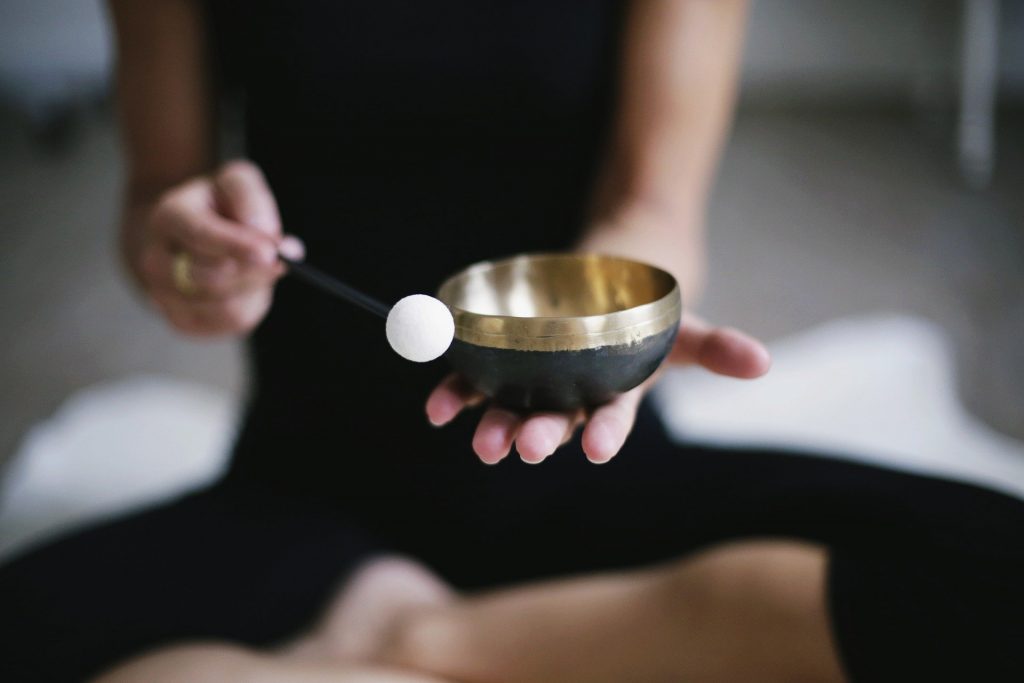Today I thought I’d share my favourite ways to be mindful, day to day. And share the techniques that help me draw my mind back to the present moment.
10 Ways To Be Mindful

1. Practice Daily Gratitude
As part of my morning routine, I like to think of 3 things I feel grateful for. And sit and ponder on how they make my life better. Doing this helps me start my day in a positive mindset and develops my appreciation for the little things in my life. They are often really the big things in hindsight.

2. In Social Settings Turn Your Phone Off
When out socialising I like to turn my phone off or put it in my handbag and refrain from checking it throughout the night.
I find this removes a big source of distraction and temptation to check for me. And allows me to be fully present with those I care about. We are always in such close proximity to our phones, that it hasbecome all to easy to continuously check them on impulse. So, do your self a favour and remove the temptation.

3. Create a Bed-time Wind Down Routine
Something I have been trying to do this year, is to turn my phone off between 7 and 8PM. Because I like to spend the last hour before bed, away from blue lights and social media stimulation. I find it helps me disconnect from the day and wind down so I’m ready to sleep.
Instead of being on my phone, I try to read a book or talk about my day with my husband. Or even sit with my thoughts and review my day. Kinda sort through any mental clutter and check in with myself. Ask myself, how am I doing. Am I feeling any unprocessed emotions? Am I tired? Stressed? Anxious? Happy? I like to ask myself what I need more and less of in my life etc. Just a bit of personal care goes a long way.
Another thing I find really helpful, is to charge my phone in another room and use a real alarm clock on the bedside. As this reduces the effects of blue light on my sleep. And allows me to fall in to a deeper sleep that much easier. It also means in the morning, I no longer automatically reach for my phone before I get out of bed and start mindlessly scrolling Instagram. Which helps me start my day feeling more alert and productive.
This new habit is one I am enjoying quite a lot. And have found the quality of my sleep is so much better as I have a lot more energy the next day.

4. Get Adequate Levels of Sleep.
Tip number 3 goes really nicely with our fourth.
So, the National Sleep Foundation in the US have done their research and found that we all have our own, unique time that is optimum to go to sleep. And it is totally unique to us and our circadian rhythme. Which means it’s up to us to workout what our own is. Sorry, but no one else can do it for you.
Most of us think we are getting optimal sleep if we are getting between 7-9hrs a night. Which is a good level of sleep. But if you are going to sleep at midnight and waking up at 9am when you’re bodies natural circadian rhythme dictates that it wants to fall asleep at 10pm the quality of your sleep won’t be as good. Despite getting 9 hrs of it.
A few years back when I was in University, I read about this philosophy of finding your best time to go to bed. And set out to find out what mine was as I was fed up of always feeling like I never got a great nights sleep. What I found was that my optimum time is between 9-9:30pm.
I have a much deeper sleep if I climb in to bed between 9 and 9:30pm. Any later than this and I always feel less rested and at times like I’ve barely slept.
So, why not try going to bed at an earlier time for 3 nights. And make notes on the quality of your sleep. For example, how easily did you fall asleep and how did you feel first thing in the morning, before you climbed out of bed. If you struggled to fall asleep it would suggest you need a later bed time. But if you were struggling to stay awake until that bedtime you need to bring it forward.
Once you have found your optimum time try to stick to it most nights. Even on the weekends and whilst away on holiday to keep our batteries charged properly. Everyone is different though, so it’s a case of needing to work out for yourself, what time works best for you.
Creating a good bedtime routine has been one of the best things I have done for my health and happiness over the past few years. I really recommend you give it a try and experiment with different bed times to see what feels best for you.

5. Take a Social Media Break
At the end of last year I decided to implement a few breaks from social media. As I was feeling burnt out and frustrated with it all if I’m honest.
I didn’t expect to find it so beneficial for my mental health though. During the break, I found I was much happier in myself and was putting less pressure on myself, to compare how I am doing day to day to what I see others doing on Instagram. The break also made me more aware of and mindful of my social media use once I started using it again. And now, I find I am more able to identify when I’m starting to go a bit over kill with my usage again.
As a result, I decided to create a few rules that now help me regulate my usage. One of them I mentioned above already. And when I do decide to scroll, I try to be aware of time passing and not get so engrossed that I lose 30-45mins of my time in one go. Because lets face it, it’s so easily done, once we launch ourselves down the social media rabbit hole.
I feel like there is starting to be more understanding around the correlation between social media usage and increased levels of anxiety and depression. And I feel it is so important to be able to recognise if our social media use is starting to become toxic. So we can do something about it for our best interests.
Just remember, it is ok to take a step back if you feel you need it. It will still be there when/ if you choose to go back to it.

6. Start a Meditation Practice
Meditation is one of the best ways to be mindful and cultivate a strong mental focus. It gives the practitioner the ability to develop a good mental presence in every day moments.
The primary focus of a mindful meditation is on ones current physical state. And is now recognised by psychotherapists as a form of cognitive therapy. And is often practiced by focusing our attention on mental relaxation, the breath or bodily sensations.
Meditation can often be daunting if you are unsure where to start. If you’re interested in reading about meditation and how you can build a meditation practice in to your daily habits, I talk about it in my blog, How To Rock Your Meditation Practice.

7. Use Pranayama Breathing Techniques
Practicing calming, breathing techniques (Pranayama) such as, Ujjayi Breathing (often referred to as the Darth Vader breath) or Nadi Shodhan Pranayma (alternate nostril breathing) can help:
- increase mental strength
- Improve the functioning of our autonomic nervous system
- Reduce stress symptoms
- Increase life expectancy
- Improves your mental perception and sound judgement
- Builds will-power
If you haven’t tried pranayama before, I really recommend it. If you want to learn about pranayma technqies, you can check out my blog on Nadi Shodhan Pranayama and Ujjaya Breathing.

8. Repeat Positive Affirmations
Another way to be mindful, is to repeat positive affirmations whenever you notice your mindset sleeping in to a negative zone.
Using positive affirmations is one of my favourite ways to be mindful and develop a better focus on my mindset.
Some days I like to start my morning by repeating positive affirmations to myself 5/10/15 times. Depending on my mood that morning. And again any time throughout the day that I feel I need them. No one needs to know you are doing this if you internalise them. So why not give it a go and see if you love the power of a positive affirmation as much as I do.

9. Go For a Mindful Walk
Taking a mindful walk is a technique where you focus on the colours, smells, sounds, sensations around you as you pass by on your daily walk. You don’t have to set time aside each day to specifially go for a mindful walk. You can just start practicing the technique on any routine walk you find yourself doing during the day.
The idea is that, when your mind begins to wander back to everyday thoughts, like how you’re going to get through your to do list or what you’re going to cook for tea, bring your thoughts back to your five senses. And just resubmerge yourself in them as best you can. Don’t worry if some days are harder than others to stop the monkey mind, that is the nature of life. It ebbs and flows. But you will still feel the benefit of giving it a try even if it doesn’t feel all that successful at the time. That’s why we call it a practice.

10. Focus on 3 Things
If at any point in your day you find yourself feeling overwhelmed, stop what you are doing and think of three things you can see, 3 things you can hear, 3 things you can feel and 3 things you can smell.
This will help you bring your racing mind back to the present moment and give you the chance to ground down and remind yourself that you are ok, right now, in this moment. It’s such an easy and effective way to instantly focus your mind on the present so you can take a few deep breaths and recollect yourself. And those are my 10 ways to be mindful.
Ultimately, there are so many great ways to be mindful with our time. It just takes a bit of thought and practice to build them in to daily habits. But the benefits we receive from bringing presence of mind to our day, can really help us deal with our day to day stresses.
I hope you have enjoyed reading about 10 ways I like to try and be mindful with my day. And I really hope you find these tips helpful in your own life.
If you are left wanting to read more ways to practice being present, I recommend reading Bustles blog on 6 Ways To Be More Present Every Single Day.
And that’s it from me today guys. Hope you have a great week.


Recent Comments